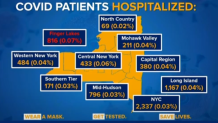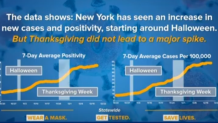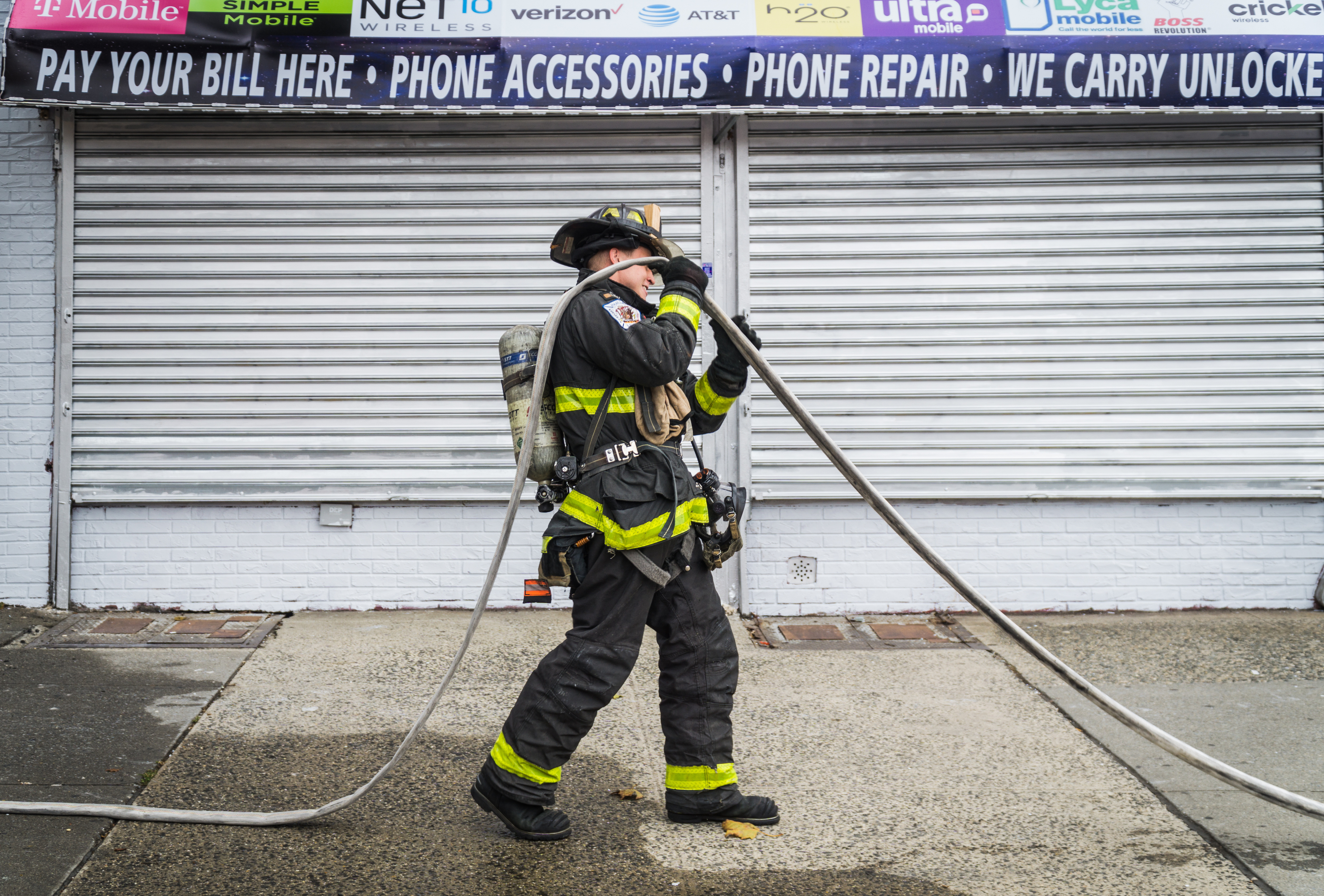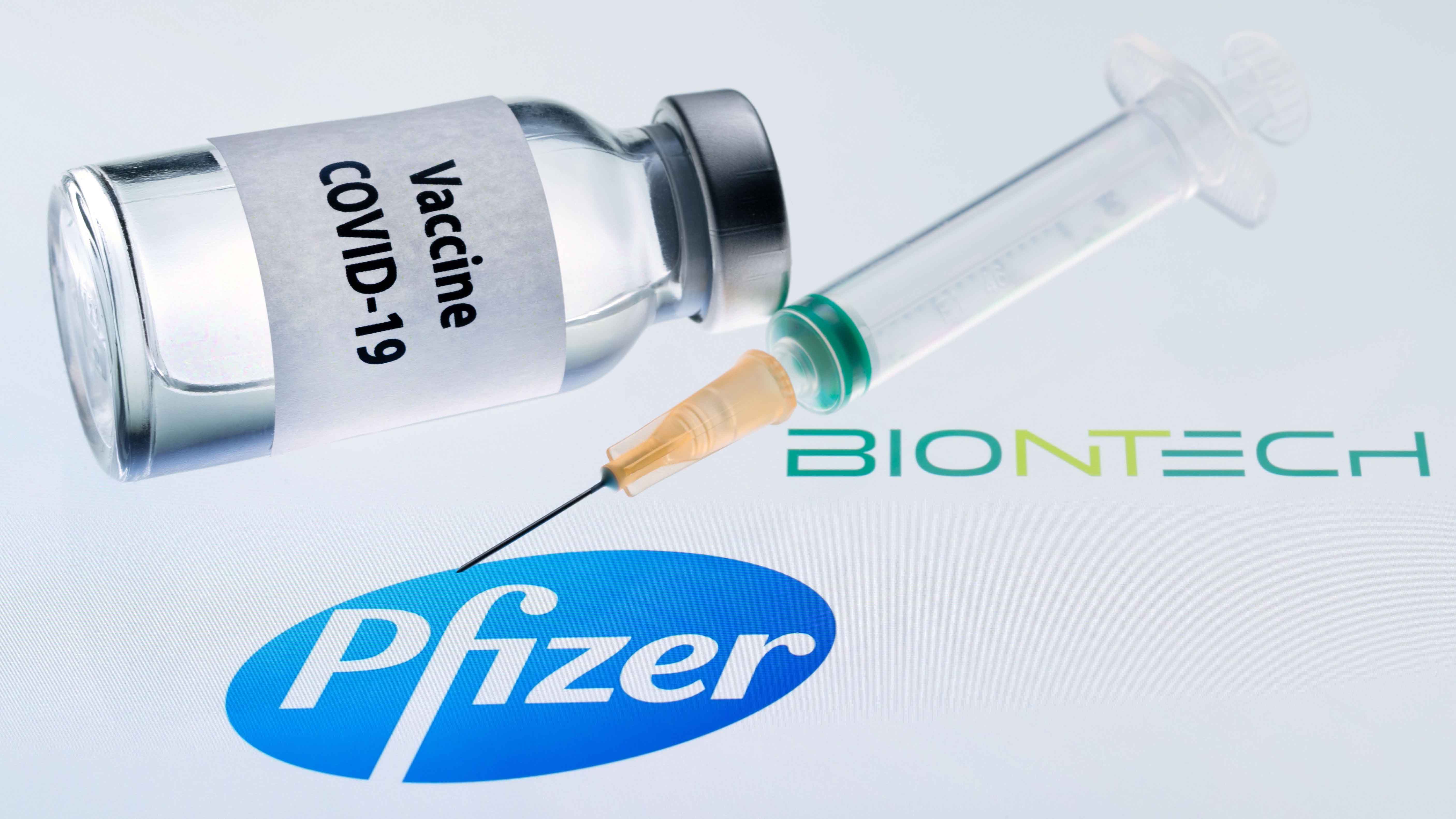What to Know
- Despite all the talk about a new NY shutdown over the last few weeks, Gov. Andrew Cuomo continues to say harsh new restrictions aren't inevitable; NYers just have to make it through one more stretch
- These upcoming end-of-year holidays will be the longest socialization stretch, he says; if New York can avoid a significant spike related to travel or gatherings, it's just a "sprint, us versus the vaccine"
- New Jersey officials are delivering the same urgent message; ICU numbers are at their highest levels in seven months, while Gov. Phil Murphy has reported two straight days of daily deaths above 100
Officials across the tri-state area are issuing their last-ditch pleas Wednesday to avoid travel, wear masks and limit gatherings -- as fears of a more virulent COVID-19 strain identified in the U.K. making its way to the region predominate the conversation.
Mayor Bill de Blasio announced new measures Wednesday to protect New York City from the new COVID strain, which has not yet been detected in the U.S. Effective immediately, U.K. travelers to New York City will be personally served a Department of Health commissioner quarantine order by the sheriff's office.
"This will be a personal and direct order to every single one of them telling them they must quarantine," the mayor said. "People are going to be held responsible."
The travel unit will knock on hotel or home doors to ensure compliance. Beyond U.K. travelers, all people coming into the city will receive a commissioner quarantine order via certified mail. Each day a person is found in violation of the quarantine order incurs a $1,000 fine.
"We cannot take chances with anyone who travels, particularly folks traveling in from the U.K.,” de Blasio said. “We don’t want to penalize people. Everyone’s been through hell this year. We don’t want to, but if you don’t follow quarantine you’re endangering everyone else in the city, right as we’re fighting the second wave.”
The efforts come as the five boroughs fight to beat back their steepest viral increases in months amid a new potential threat. New hospital admissions for COVID topped 200 (224) for the first time in 10 days, de Blasio said Wednesday and remained above the mayor's threshold Thursday. The seven-day rolling positivity rate, meanwhile, climbed to 6.29 percent, the mayor said.
"It may be Christmas EVE, but COVID-19 isn't taking the holiday off," the mayor tweeted as he reported the city's daily indicators.
Statewide, hospitalization and daily death numbers continue to rise. Gov. Andrew Cuomo reported more than 100 deaths (164) Wednesday for the eighth time in nine days as hospitalizations climbed to 6,864, the highest total since May 12.
The Finger Lakes region has become problematic as far as hospitalization rates, Cuomo says. On Wednesday, he said his administration was considering several options because "that is a serious and deadly situation and it's not getting better."
Mohawk Valley is also of concern, Cuomo said, noting he'll be talking to officials there as well and strategizing with his team to determine potential next steps.

The governor expects the numbers overall to keep rising between now and New Year's. If they rise to a point where any individual hospital in the state notifies the health department it is 21 days from hitting 85 percent capacity, that would begin a churning of the state's economic shutdown mechanisms for the given region.
No hospital has notified the state of such an imminent capacity threat yet -- and Cuomo says he believes it won't come to that if New Yorkers are responsible.
Data shows New York's increase in new cases and positivity rates traces back to Halloween, but Thanksgiving didn't lead to the same major spike seen elsewhere. The governor identifies air and other travel, which he calls a "proxy for more social gatherings," as the key differential for other U.S. states and major cities.

"Our actions this week determine what lies ahead. Do we stay as diligent? How high does it go up? How fast does it go up? We are not destined for shutdown," Cuomo said Wednesday. "Celebrate, but just be smart about the way you celebrate. Celebrate smart, stop the shutdowns."
That's also been the message in New Jersey, where Gov. Phil Murphy witnessed frontline workers get the Moderna vaccine in Toms River Wednesday morning before heading to Trenton for his afternoon COVID briefing.
Murphy reported a daily death toll above 100 Tuesday for the first time in months, and then did it again Wednesday. It was the first time since late May that the death toll topped 100 two days in a row. On Wednesday he said there were 765 COVID patients in the state's ICUs -- the largest number in seven months.
Total hospitalizations have climbed to 3,841, their highest level since May 13.
"What's the lead versus the lag? Could we get up to 6,000 hospitalizations? The answer is, unfortunately, yes," Murphy said. He believes there's room for optimism, given slower-than-spring increases over the last month and a half. The transmission rate, for one, while alarming compared with recent numbers at slightly above 1.0 is well below the 5.0-plus rate the state saw in the spring. Although below the levels seen earlier this year, hospitalizations from the virus have been increasing recently, he said.
“That’s one thing we can’t let happen, to let our hospital systems get overrun,” he said. “This year cannot be the year for (a) large Christmas with family and friends; this is the way it’s got to be. We don’t want anybody’s Christmas to lead to anybody becoming sick or hospitalized.”
The governor on Wednesday used his final coronavirus briefing before the holiday to urge New Jerseyans not to gather with extended family as a means of limiting the spread of the virus.
“You’re sick of hearing this, and I don’t blame you, but don’t screw up Christmas,” he said. “Don’t go big. Don’t go multi-generational. Stay within your immediate family.”
At the same time they issue their final holiday warnings, all three officials also are keenly monitoring the developing situation in the U.K., where a viral mutation has emerged that appears to be up to 50 percent more transmissible. It also may more easily infect children, though little is known about the strain at this point.
There is no evidence yet that the new strain is more lethal or causes more severe infections, but if it spreads more easily, it will by default lead to more cases, which will lead to more hospitalizations and some level of increase in deaths as well.
So far, it only has been detected in the U.K., Denmark, the Netherlands and Australia, according to the World Health Organization. While it hasn't yet been found in the U.S., the CDC says it may already be circulating here undetected. The agency has sequenced genetic coding from less than 0.3 percent of U.S. cases.
Cuomo believes it's already in New York -- if something spreads globally, it ends up here -- but he wants to know when it's confirmed. And where it's been detected. The governor has ordered hospitals across the state to begin testing for the new variant. The Wadsworth Center, a state lab, has sequenced genetic coding from 3,700 New York samples thus far and has not detected the mutation, Cuomo said.
Daily Percentage of Positive Tests by New York Region
Gov. Andrew Cuomo breaks the state into 10 regions for testing purposes and tracks positivity rates to identify potential hotspots. Here's the latest tracking data by region and for the five boroughs. For the latest county-level results statewide, click here
Source: ny.gov
The lab and the Department of Health forged agreements with six hospitals to obtain additional samples and are working with others to acquire more test data. Hospitals can send positive COVID samples to be tested for the new strain, the governor said Wednesday. Email COVIDstrain@health.ny.gov for more details.
"If it's here, we want to know it, we want to isolate it immediately," Cuomo said. "If it is more easily transmissible, we want to catch it in the crib. We want to find patient zero on that variant."
Cuomo is concerned that the new strain, should it continue to spread, could bring about the second wave of coronavirus that many have feared for so long. That's what happened with the Spanish flu, he says.
Until more information is learned about the new strain, he has called on the federal government to halt travel between the United Kingdom and the United States. More than three dozen countries have barred flights from Britain since the variant prompted a new lockdown there; a number of others imposed restrictions.
On top of those, 120 countries require inbound U.K. travelers to provide proof of a negative COVID test before departure. Cuomo says the Port Authority doesn't have legal jurisdiction to require that at New York's airports, so he asked three major airlines -- British Airways, Delta, Virgin Atlantic -- that fly between the U.K. and New York daily to voluntarily agree to add New York to the test mandate list.
By early Monday evening, all three had agreed. However, some of the testing doesn't go into effect until Thursday, so travelers coming from the U.K. on Wednesday said they did not have to get COVID tests before leaving — which left Cuomo fuming at CDC and Homeland Security officials for not requiring the tests or banning flights.
"When did common sense leave government?" Cuomo said. "I don't know if they're just checked out, but if they're checked out, they should resign."
According to the CDC, the new strain, dubbed SARS-CoV-2 VUI 202012/01, became prevalent in southeast England in November and accounts for up to 60 percent of recent infections in London. Viruses mutate all the time, the agency notes, so this one could have emerged by chance. Or it "may be emerging because it is better fit to spread in humans," the CDC said.
Tracking Coronavirus in Tri-State
That it developed so rapidly from a rare strain in the U.K. to a common one is a concern, the agency added. In a CNN interview Wednesday, CDC Director-designate Rochelle Walensky said travel bans, quarantines and testing-upon-arrival are all viable strategies as far as containing the mutant strain.
"We’ve been saying to the American people we need to limit our mobility period, that’s the best way to control the mutant strain so it doesn’t explode in other places," Walensky noted.
"We need to promote vaccine distribution and vaccination, we need to get more vaccines into people and promote more testing," she added. "The mutant strain has made us realize we’re not done with testing."
Experts and doctors believe existing vaccines should be able to fight infection from new variants because emerging strains are likely to be genetically similar to prior ones. The CEO of BioNTech, which is behind Pfizer's drug, said Tuesday it is "highly likely that the immune response by this vaccine also can deal with the new virus variant." Additional testing to confirm that is underway, though data from those experiments likely won't be available for a number of weeks.
Meanwhile, officials in the tri-state area are forging ahead with plans to inoculate as many frontline healthcare workers and nursing home residents and staff as they can to ensure heightened protection from the strain they know is here.
New York state has administered 89,000 initial vaccine doses to date, Cuomo said Wednesday. In the first two days of the nursing home program, 22,000 vaccines were administered in 90 facilities, Cuomo said. He has called on hospitals and nursing homes to continue vaccination efforts through the holidays to keep pace.
New York City is vaccinating at a rate twice the national average, Mayor de Blasio has said -- and the city's EMTs are receiving their first doses Wednesday. FDNY Chief Daniel Nigro joined the mayor's news briefing in support of the opportunity.
Of more than 30,000 vaccine doses administered in the city thus far, officials have received one report of a serious adverse event -- a significant allergic reaction in a healthcare worker, the health department said Wednesday. That worker has been treated and is in stable condition, officials said.
More on the Vaccine
"The City Health Department is closely tracking reports of more severe side effects in collaboration with the CDC, and this is the first serious adverse event we have encountered in New York City," officials said. "We will continue to move forward with the coronavirus vaccine distribution to ensure that health care workers and nursing home staff and residents are protected against COVID-19."
Statewide, New York has received 630,000 vaccine doses thus far and expects to get another 300,000 next week, Cuomo said Tuesday.
The process is also well underway in New Jersey. As of 11 a.m. Wednesday, 27,730 healthcare workers had received their first doses in 64 hospitals and six other sites, health commissioner Judy Persichilli said. The state received more than 200,000 doses of Moderna and Pfizer vaccines this week, she added.
The race to vaccinate the general public couldn't be more urgent. Deaths have occurred at a faster rate over the last week than at any other time during the pandemic, with 3,350 COVID-related deaths reported in the U.S. on Tuesday.
The country has recorded more than 319,000 deaths since the start of the pandemic and topped more than 18 million cases, according to NBC News. Both tolls are likely much higher than reported.
New York alone has confirmed nearly 30,000 COVID deaths since the start of the pandemic, more than 17,000 of those in the city, and likely has thousands more attributable to it in some way. California, which has the fastest growing case rate in the country, surpassed two million cases early Thursday morning, according to NBC News, becoming the first state to cross that threshold. It took more than 250 days for the state to have a million cases, and just 42 days to get another million.
Nationally, 2020 is the deadliest year in U.S. history. Total deaths are expected to top 3 million for the first time — due mainly to the coronavirus pandemic.





